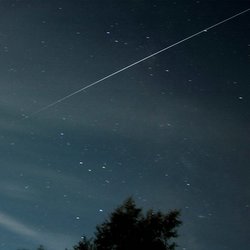
The International Space Station streaks overhead. Image credit: Gregory Blount. Click to enlarge.

Space and astronomy news

The International Space Station streaks overhead. Image credit: Gregory Blount. Click to enlarge.
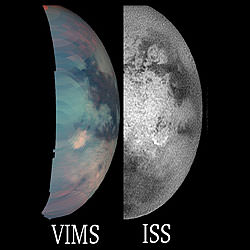
Bright spot on Titan. Image credit: NASA/JPL/University of Arizona/Space Science Institute Click to enlarge.
A 300-mile-wide patch that outshines everything else on Titan at long infrared wavelengths appears not to be a mountain, a cloud or a geologically active hot spot, University of Arizona scientists and Cassini team members say.
“We must be looking at a difference in surface composition,” said Jason W. Barnes, a postdoctoral researcher at UA’s Lunar and Planetary Lab. “That’s exciting because this is the first evidence that says not all of the bright areas on Titan are the same. Now we have to figure out what those differences are, what might have caused them.”
When NASA’s Cassini spacecraft flew by Titan on March 31 and again on April 16, its visual and infrared mapping spectrometer saw a feature that was spectacularly bright at 5-micron wavelengths just southeast of the continent-sized region called Xanadu.
The bright spot occurs where Cassini’s visible-wavelength imaging cameras photographed a bright arc-shaped feature approximately the same size in December 2004 and February 2005.
Cassini’s radar instrument, operating in the “passive” mode that is sensitive to microwaves emitted from a planetary surface, saw no temperature difference between the bright spot and surrounding region. That rules out the possibility that the 5-micron bright spot is a hot spot, such as a geologically active ice volcano, Barnes said.
Cassini microwave radiometry also failed to detect a temperature drop that would show up if some two-mile high mountain rose from Titan’s surface, he said.
And if the 5-micron bright spot is a cloud, it’s a cloud that hasn’t moved or changed shape for three years, according to ground-based observations made at the Keck Telescope and with Cassini’s visual and infrared mapping spectrometer during five different flybys. “If this is a cloud,” Barnes said, “it would have to be a persistent ground fog, like San Francisco on steroids, always foggy, all the time.”
“The bright spot must be a patch of surface with a composition different from anything we’ve seen yet. Titan’s surface is primarily composed of ice. It could be that something is contaminating the ice here, but what this might be is not clear,” Barnes said.
“There’s a lot left to explore about Titan. It’s a very complex, exciting place. It’s not obvious how it works. It’s going to be a lot of fun over the next couple of years figuring out how Titan works,” he said.
Barnes and 34 other scientists report the research in the Oct. 7 issue of Science. Authors include UA Lunar and Planetary Laboratory scientists and Cassini team members Robert H. Brown, head of Cassini’s visual and infrared mapping spectrometer team; Elizabeth P. Turtle and Alfred S. McEwen of the Cassini imaging team; Ralph D. Lorenz of the Cassini radar team; Caitlin Griffith of the Cassini visual and infrared mapping team; and Jason Perry and Stephanie Fussner, who work with McEwen and Turtle on Cassini imaging.
The Cassini-Huygens mission is a cooperative project of NASA, the European Space Agency and the Italian Space Agency. The Jet Propulsion Laboratory, a division of the California Institute of Technology in Pasadena, Calif., manages the mission for NASA’s Science Mission Directorate, Washington, D.C. The Cassini orbiter and its two onboard cameras were designed, developed and assembled at JPL. The imaging team is based at the Space Science Institute in Boulder, Colo. The Visual and Infrared Mapping Spectrometer team is based at The University of Arizona in Tucson .
Original Source: UA News Release
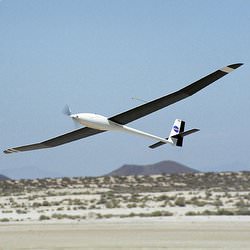
Unmanned prototype sailplane. Image credit: NASA. Click to enlarge.
With the graceful flight of hawks and eagles in mind, NASA aerospace engineer Michael Allen recently hand-launched a 15-pound motorized model sailplane over the Southern California desert. He was hoping it would catch plumes of rising air called thermals.
The sailplane did just that several times without human intervention during a series of research flights at NASA’s Dryden Flight Research Center, Calif. The tests validated Allen’s premise that using thermal lift could significantly extend the range and flight endurance of small unmanned air vehicles. Thermal lift increases vehicle endurance and saves fuel. This is significant, as small vehicle flight duration is often restricted by limited fuel capacity.
Allen and his team of engineers and technicians flew the remote-controlled RnR Products sailplane 17 times from July through mid-September. The sailplane was modified by Dryden aerospace technicians to incorporate a small electric motor and an autopilot programmed to detect thermals.
The 14-foot-wingspan model flew to an altitude of about 1,000 feet. The ground-based remote control pilot then handed off control to the sailplane’s onboard autopilot. The autopilot software flew the plane on a pre-determined course over the northern portion of Rogers Dry Lake at Edwards Air Force Base, Calif., until it detected an updraft. As the aircraft rose with the updraft, the engine automatically shut off. The aircraft circled to stay within the lift from the updraft.
Allen said the small sailplane added 60 minutes to its endurance by autonomous thermal soaring. The modified sailplane gained an average altitude in 23 updrafts of 565 feet, and in one strong thermal ascended 2,770 feet.
“The flights demonstrated a small unmanned vehicle can mimic birds and exploit the free energy that exists in the atmosphere,” Allen said. “We have been able to gather useful and unique data on updrafts and the response of the aircraft in updrafts. This will further the technology and refine the algorithms used.”
Small, portable, unpiloted, long-endurance vehicles could fulfill a number of observation roles including forest fire monitoring, traffic control, search and rescue.
For more information about flight research at Dryden on the Web visit:
http://www.nasa.gov/centers/dryden
For information about NASA and agency programs on the Web, visit:
http://www.nasa.gov/home
Original Source: NASA News Release
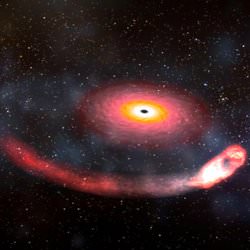
Artist illustraton of a black hole consuming a neutron star. Image credit: Dana Berry/NASA. Click to enlarge.
Scientists have solved a 35-year-old mystery of the origin of powerful, split-second flashes of light called short gamma-ray bursts. These flashes, brighter than a billion suns yet lasting only a few milliseconds, have been simply too fast to catch… until now.
If you guessed that a black hole is involved, you are at least half right. Short gamma-ray bursts arise from collisions between a black hole and a neutron star or between two neutron stars. In the first scenario, the black hole gulps down the neutron star and grows bigger. In the second scenario, the two neutron stars create a black hole.
Gamma-ray bursts, the most powerful explosions known, were first detected in the late 1960s. They are random, fleeting, and can occur from any region of the sky. Try finding the location of a camera flash somewhere in a vast sports stadium and you’ll have a sense of the challenge facing gamma-ray burst hunters. Solving this mystery took unprecedented coordination among scientists using a multitude of ground-based telescopes and NASA satellites.
Two years ago scientists discovered that longer bursts, lasting over two seconds, arise from the explosion of very massive stars. About 30 percent of bursts, however, are short and under two seconds.
Four short gamma-ray bursts have been detected since May. Two of these are featured in four papers in the October 6 issue of Nature. One burst from July provides the “smoking gun” evidence to support the collision theory. Another burst goes a step further by providing tantalizing, first-time evidence of a black hole eating a neutron star—first stretching the neutron star into a crescent, swallowing it, and then gulping up crumbs of the broken star in the minutes and hours that followed.
These discoveries might also aid in the direct detection of gravitational waves, never before seen. Such mergers create gravitational waves, or ripples in spacetime. Short gamma-ray bursts could tell scientists when and where to look for the ripples.
“Gamma-ray bursts in general are notoriously difficult to study, but the shortest ones have been next to impossible to pin down,” said Dr. Neil Gehrels of NASA Goddard Space Flight Center in Greenbelt, Md., principal investigator of NASA’s Swift satellite and lead author on one of the Nature reports. “All that has changed. We now have the tools in place to study these events.”
The Swift satellite detected a short burst on May 9, and NASA’s High-Energy Transient Explorer (HETE) detected another on July 9. These are the two bursts featured in Nature. Swift and HETE quickly and autonomously relayed the burst coordinates to scientists and observatories via cell phone, beepers and e-mail.
The May 9 event marked the first time scientists identified an afterglow for a short gamma-ray burst, something commonly seen after long bursts. That discovery was the subject of a May 11 NASA press release. The new results published in Nature represent thorough analyses of these two burst afterglows, which clinch the case for the origin of short bursts.
“We had a hunch that short gamma-ray bursts came from a neutron star crashing into a black hole or another neutron star, but these new detections leave no doubt,” said Dr. Derek Fox of Penn State, lead author on one Nature report detailing a multi-wavelength observation.
Fox’s team discovered the X-ray afterglow of the July 9 burst with NASA’s Chandra X-ray Observatory. A team led by Prof. Jens Hjorth of the University of Copenhagen then identified the optical afterglow using the Danish 1.5-meter telescope at the La Silla Observatory in Chile. Fox’s team then continued its studies of the afterglow with NASA’s Hubble Space Telescope; the du Pont and Swope telescopes at Las Campanas, Chile, funded by the Carnegie Institution; the Subaru telescope on Mauna Kea, Hawaii, operated by the National Astronomical Observatory of Japan; and the Very Large Array, a stretch of 27 radio telescopes near Socorro, N.M., operated by the National Radio Astronomy Observatory.
The multi-wavelength observation of the July 9 burst, called GRB 050709, provided all the pieces of the puzzle to solve the short burst mystery.
“Powerful telescopes detected no supernova as the gamma-ray burst faded, arguing against the explosion of a massive star,” said Dr. George Ricker of MIT, HETE Principal Investigator and co-author of another Nature article. “The July 9 burst was like the dog that didn’t bark.”
Ricker added that the July 9 burst and probably the May 9 burst are located in the outskirts of their host galaxies, where old merging binaries are expected to be. Short gamma-ray bursts are not expected in young, star-forming galaxies. It takes billions of years for two massive stars, coupled in a binary system, to first evolve to the black hole or neutron star phase and then to merge. The transition of a star to a black hole or neutron star involves an explosion (supernova) that can kick the binary system far from its origin and out towards the edge of its host galaxy.
This July 9 burst and a later one on July 24 showed unique signals that point to not just any old merger but, more specifically, a black hole – neutron star merger. Scientists saw spikes of X-ray light after the initial gamma-ray burst. The quick gamma-ray portion is likely a signal of the black hole swallowing most of the neutron star. The X-ray signals, in the minutes to hours that followed, could be crumbs of neutron star material falling into the black hole, a bit like dessert.
And there’s more. Mergers create gravitational waves, ripples in spacetime predicted by Einstein but never detected directly. The July 9 burst was about two billion light years away. A big merger closer to the Earth could be detected by the National Science Foundation’s Laser Interferometer Gravitational-Wave Observatory (LIGO). If Swift detects a nearby short burst, LIGO scientists could go back and check the data with a precise time and location in mind.
“This is good news for LIGO,” said Dr. Albert Lazzarini, of LIGO Laboratory at Caltech. “The connection between short bursts and mergers firms up projected rates for LIGO, and they appear to be at the high end of previous estimates. Also, observations provide tantalizing hints of black hole – neutron star mergers, which have not been detected before. During LIGO’s upcoming yearlong observation we may detect gravitational waves from such an event.”
A black hole – neutron star merger would generate stronger gravitational waves than two merging neutron stars. The question now is how common and how close these mergers are. Swift, launched in November 2004, can provide that answer.
Original Source: NASA News Release
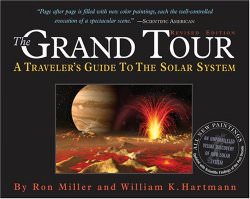
Our solar system rates little more than an acknowledgement from the average person. Simple rhymes from grade school help us memorize the planet names and their order from closest to the Sun to farthest out. As the solar system changes ever so slightly in the brevity of the average person’s life, this is reasonable. However, we have been lucky enough to have recently seen the bright comets Halley and Hale-Bopp trek by the sun. Then comet Shoemaker-Levy 9 disintegrated and slammed into Jupiter. In keeping with this awakening interest, we routinely scan the skies for asteroids that might impact our Earth. With all this activity, it becomes obvious our solar system is anything but routine. Hence, a travel guide is an excellent resource for learning more.
Miller and Hartmann’s tour book is a great complement for those wanting to know more about the worlds circling our Sun. Using the tools of artists, together with the concise detailing of science, the far away worlds come alive before our eyes. Distinct chapters highlight individual planets and the smaller worlds. The presentation stresses a view as if for a visitor rather than an occupant of Earth. In following this vein, the authors start with the largest planet, Jupiter. A fairly regular description then ensues. The atmosphere, its properties and constituent matter get appraised. The surface shape, colour, and any novel features characterize the world. Then last, the interior gets mentioned often as a tie-in to the formation process of the solar system. Understandably, the authors have to rely on knowledge gained from probes sent and surveys undertaken by humankind, so the details of Venus, Earth and Mars are lengthy while many others are quite short and rather impersonal. For instance, Asteroid 6178 gets a two page entry, principally due to it being a pure nickel-iron alloy. But it and manner others do get mentioned.
Setting this book apart from your garden variety tour guide are the graphics and images. Hundreds of large and small coloured plates place the reader directly at the subject’s location. There’s one as if the viewer is standing in the middle of Saturn’s ring watching hundreds of fellow ring objects dance along. Or picture yourself on one lobe of the compound asteroid 624 Hektor looking down at a strange connecting valley and on up to the next lobe. Many images are grand vistas where the viewer is on an orbiting world with a planet filling the distance. For example there’s the cliff of Miranda while the ring system of Uranus defines a blue back drop. With accurate angles and perspectives it is often difficult to separate the computer drawn images to real photographs. Nevertheless, with this book in hand, all you need is a vehicle and you’d be off wandering to your favourite.
The format of the book (long rather than tall) further enhances these images, as many two paged vistas are quite breathtaking. These and the complementary text keep the reader pressing forward to find more wondrous natural sights of space. Further, even though this is the third edition, the images and data aren’t dated, as much information is recent. And don’t let the 3D hologram on the front cover make you think this book is purely for children. The detail and presentation is much more apropos for secondary school students or the beginning space buff. However, given the strength of the artwork, I was disappointed at the brevity of the section for worlds Beyond Our Solar System. There would be little to lose and, I think, much to gain from letting learned imaginations fill wide vistas of planets in other solar systems.
Our solar system keeps our special planet Earth in just the right location to allow our own happy lives. This doesn’t, however, bind us to this paradise. Other exciting, unique and pictorially sensational worlds grace our passage about our Sun. So read Ron Miller and William K. Hartmann’s book The Grand Tour, A Traveler’s Guide to the Solar System and get acquainted or re-acquainted with the beauty and relevance of these other worlds that share our immediate space.
Review by Mark Mortimer
Read more reviews online, or purchase a copy from Amazon.com.
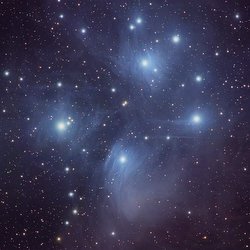
M45 aka Pleiades. Image credit: Tom Davis. Click to enlarge.
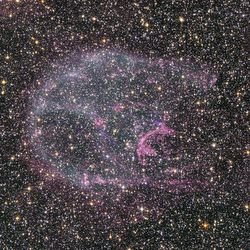
Supernova remnant N132D. Image credit: Hubble. Click to enlarge.
Intricate wisps of glowing gas float amid a myriad of stars in this image created by combining data from NASA’s Hubble Space Telescope and Chandra X-ray Observatory. The gas is a supernova remnant, cataloged as N132D, ejected from the explosion of a massive star that occurred some 3,000 years ago. This titanic explosion took place in the Large Magellanic Cloud, a nearby neighbor galaxy of our own Milky Way.
The complex structure of N132D is due to the expanding supersonic shock wave from the explosion impacting the interstellar gas of the LMC. Deep within the remnant, the Hubble visible light image reveals a crescent-shaped cloud of pink emission from hydrogen gas, and soft purple wisps that correspond to regions of glowing oxygen emission. A dense background of colorful stars in the LMC is also shown in the Hubble image.
The large horseshoe-shaped gas cloud on the left-hand side of the remnant is glowing in X-rays, as imaged by Chandra. In order to emit X-rays, the gas must have been heated to a temperature of about 18 million degrees Fahrenheit (10 million degrees Celsius). A supernova-generated shock wave traveling at a velocity of more than four million miles per hour (2,000 kilometers per second) is continuing to propagate through the low-density medium today. The shock front where the material from the supernova collides with ambient interstellar material in the LMC is responsible for these high temperatures.
It is estimated that the star that exploded as a supernova to produce the N132D remnant was 10 to 15 times more massive than our own Sun. As fast-moving ejecta from the explosion slam into the cool, dense interstellar clouds in the LMC, complex shock fronts are created.
A supernova remnant like N132D provides a rare opportunity for direct observation of stellar material, because it is made of gas that was recently hidden deep inside a star. Thus it provides information on stellar evolution and the creation of chemical elements such as oxygen through nuclear reactions in their cores. Such observations also help reveal how the interstellar medium (the gas that occupies the vast spaces between the stars) is enriched with chemical elements because of supernova explosions. Later on, these elements are incorporated into new generations of stars and their accompanying planets.
Visible only from Earth’s southern hemisphere, the LMC is an irregular galaxy lying about 160,000 light-years from the Milky Way. The supernova remnant appears to be about 3,000 years old, but since its light took 160,000 years to reach us, the explosion actually occurred some 163,000 years ago.
This composite image of N132D was created by the Hubble Heritage team from visible-light data taken in January 2004 with Hubble’s Advanced Camera for Surveys, and X-ray images obtained in July 2000 by Chandra’s Advanced CCD Imaging Spectrometer. This marks the first Hubble Heritage image that combines pictures taken by two separate space observatories. The Hubble data include color filters that sample starlight in the blue, green, and red portions of the spectrum, as well as the pink emission from glowing hydrogen gas. The Chandra data are assigned blue in the color composite, in accordance with the much higher energy of the X-rays, emitted from extremely hot gas. This gas does not emit a significant amount of optical light, and was only detected by Chandra.
Original Source: Hubble News Release
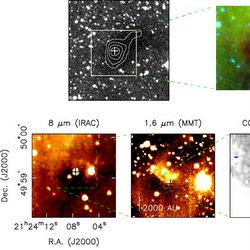
Mysterious dust cloud in various wavelengths. Image credit: CfA. Click to enlarge.
In an exercise that demonstrates the power of a multiwavelength investigation using diverse facilities, astronomers at the Harvard-Smithsonian Center for Astrophysics (CfA) have deciphered the true nature of a mysterious object hiding inside a dark cosmic cloud. They found that the cloud, once thought to be featureless, contains a baby star, or possibly a failed star known as a “brown dwarf,” that is still forming within its dusty cocoon.
Observations indicate that the mystery object has a mass about 25 times that of Jupiter, which would place it squarely in the realm of brown dwarfs. However, its mass may eventually grow large enough to qualify it as a small star. The object also is cool and faint, shining with less than 1/20 the sun’s luminosity.
“This object is the runt of the star formation family,” said CfA astronomer Tyler Bourke.
Establishing the true nature of the object required the unique capabilities of the Submillimeter Array (SMA) in Hawaii. “The SMA spotted what no single-dish telescope could see,” said Bourke.
Using the SMA, scientists detected a weak outflow of material predicted by star formation theories. That outflow – 10 times smaller in mass than any seen before – confirmed both the low-mass nature of the object and its association with the surrounding dark cloud. “The sensitivity and resolution of the Submillimeter Array with its multiple antennas were crucial in detecting the outflow,” said Bourke.
The puzzling object was discovered using a Smithsonian-developed infrared camera on board NASA’s Spitzer Space Telescope. Spitzer studied the dusty cosmic cloud named L1014 as part of the Cores to Disks Legacy program. A core is the densest region of a cloud, massive enough to make a star like the sun.
L1014, located about 600 light-years away in the constellation Cygnus the Swan, initially was classified as a “starless core” because it showed no evidence for star formation. Astronomers were surprised when Spitzer images revealed a faint infrared light source that appeared to be within the core.
Additional data were needed to confirm that the faint object was directly associated with the dark core, rather than being a chance superposition of a more distant, more mundane background object.
Near-infrared observations by the MMT Observatory in Arizona revealed a scattered light nebula surrounding the faint central object in L1014. “Light from the object is bouncing off surrounding dust and toward us,” said CfA astronomer Tracy Huard, who took the MMT images. “Reflection nebulosity like that is a fingerprint of an embedded object.”
The apparent size of the nebulosity indicated that the light source likely was located within L1014 and not in a more distant cloud. MMT data also gave investigators the orientation in space, or tilt, of the object within L1014. Astronomers then turned to the SMA for final confirmation.
“The Spitzer observations gave us hints to the nature of the object inside L1014. The MMT strengthened the association between the infrared source and the starless core. The Submillimeter Array clinched the case and revealed this object’s true identity,” said Bourke.
By studying faint, young objects like the one still forming within L1014, astronomers hope to learn more about the early stages of star formation.
“The most elusive part of star formation is the moment of birth,” said CfA astronomer Phil Myers. “In order to answer how it happens, you need examples of very young systems. This system is only about 10,000 to 100,000 years old – a baby as far as stars or brown dwarfs go.”
The combined capabilities of Spitzer, the SMA and the MMT were essential for finding and examining this object. Those facilities undoubtedly will prove useful in studying similar very dim, very young objects – objects so young that they are still growing. “They’re so young and faint that we can’t tell how much mass they will accumulate,” Myers added. “There’s no prenatal test for these objects. We’re not sure exactly what we’ll get in the end!”
A paper by Tyler L. Bourke et al. covering the SMA observations will be published in an upcoming issue of The Astrophysical Journal Letters and is available online at http://arxiv.org/abs/astro-ph/0509865.
A second paper by Tracy L. Huard et al. covering the MMT observations will be published in The Astrophysical Journal and is available online at http://arxiv.org/abs/astro-ph/0509302.
Headquartered in Cambridge, Mass., the Harvard-Smithsonian Center for Astrophysics (CfA) is a joint collaboration between the Smithsonian Astrophysical Observatory and the Harvard College Observatory. CfA scientists, organized into six research divisions, study the origin, evolution and ultimate fate of the universe.
Original Source: CfA News Release

The Great Barrier Reef, photographed by Envisat. Image credit: ESA. Click to enlarge.
Australian researchers have found Envisat’s MERIS sensor can detect coral bleaching down to ten metres deep. This means Envisat could potentially monitor impacted coral reefs worldwide on a twice-weekly basis.
Coral bleaching happens when symbiotic algae living in symbiosis with living coral polyps (and providing them their distinctive colours) are expelled. The whitening coral may die with subsequent impacts on the reef ecosystem, and thus fisheries, regional tourism and coastal protection. Coral bleaching is linked to sea temperatures above normal summer maxima and to solar radiation. Bleaching may take place on localised and mass scales ? there was an extensive bleaching event in 1998 and 2002 likely linked to El Ni?o events.
“An increase in frequency of coral bleaching may be one of the first tangible environmental effects of global warming,” states Dr. Arnold Dekker of Australia’s Commonwealth Scientific and Industrial Research Organisation?s (CSIRO) Wealth from Oceans Flagship program.”The concern is that coral reefs might pass a critical bleaching threshold beyond which they are unable to regenerate.”
Aerial or boat-based observation is the current method of detecting bleaching, but many reefs are either inaccessible or simply too large (the Great Barrier Reef has an area of 350 000 square kilometres) for an event that happens within a fortnight. Bleached corals may rapidly be colonised by blue-green to brown algae, more difficult to distinguish from live coral.
Repetitive, objective and broad-scale satellite coverage is the alternative. At this week’s MERIS/AATSR Workshop in Frascati, Italy, the CSIRO team presented initial results using Envisat’s Medium Resolution Imaging Spectrometer (MERIS). MERIS acquires images in 15 different spectral bands at 300 m resolution.
“Coral bleaching needs to be mapped at the global scale,” Dekker adds. “High-spatial resolution satellites can only do it on a few reefs due to cost and coverage constraints. We need a system that has appropriate coverage and revisit frequency, with a sufficient amount of spectral bands and sensitivity. There is no more suitable system than MERIS.”
The team studied Heron Island reef at the southern end of the Great Barrier Reef, site of a University of Queensland research station. Validating MERIS Full Resolution mode results, they found that observed changes in live coral cover were correlated to an existing bleaching event.
Theoretical studies indicate that for each complete 300-metre pixel of coral under one metre of water it is possible to detect a 2% bleaching of live coral. MERIS should remain sensitive to detecting from 7-8% bleached coral even under ten metres of water.
“MERIS Full Resolution covers the world every three days, a bottleneck for global monitoring could be data processing,” Dekker concludes. “However satellite sensors measuring sea surface temperature such as Envisat’s Advanced Along Track Scanning Radiometer (AATSR) can be applied to prioritise reefs that are subject to sea temperature heating anomalies-thus focusing the MERIS based bleaching detection.
Australia’s Great Barrier Reef Marine Park Authority has expressed interest in the project. Australian scientists plan to progress to perform MERIS monitoring of bleaching events up to the scale of the whole Great Barrier Reef.
Original Source: ESA News Release
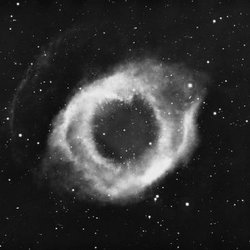
The Helix Nebula. Image credit: NOAO/AURA/NSF. Click to enlarge.
Monday, October 3 – Today marks a terrific event as viewers in Africa had a chance to witness an annular solar eclipse. Many parts of both Europe and Asia were also treated to a partial eclipse as well, so be sure the check the pages of Mr. Eclipse for links to times, locations, images, etc.
For those of us who didn’t get to see the solar ring, let’s look for a ring of another type. Tonight’s dark sky object is a difficult one for northern observers and is truly a challenge. Around a handspan south of Zeta Aquarii and just a bit west of finderscope star Upsilon is a remarkably large area of nebulosity that is very well suited to large binoculars, rich field telescopes and wide field eyepieces. Are you ready to walk into the “Helix”?
Known as NGC 7293, this faint planetary nebula “ring” structure is around half the size of the full Moon. While its total magnitude of 6.5 and large size should denote an easy find, the “Helix” is anything but easy because of its low surface brightness nature. Binoculars will show it as a large, round, hazy spot while small telescopes with good seeing conditions will have a chance to outshine larger ones by using lower power eyepieces to pick up this braided ring structure.
As one of the very closest of planetary nebula, the NGC 7392 is very similar in structure to the famous “Ring” – M57. It is a spherical shell of gas lighted by an extremely hot, tiny central star that’s only around 2% of our own Sun’s diameter – yet exceeds a surface temperature of over 100,000 kelvin. Can you resolve it? Best of luck!
Tuesday, October 4 – Today in 1957, the USSR made history as Sputnik 1 became the first manmade object to orbit the earth.
Orbiting a bit further out is the new comet in town – C/2005 E2 (McNaught). Located in the southeastern portion of southern Saggitarius, E2 is around five degrees east of Alpha Corona Australis and just a breath south. Now holding a magnitude of an estimated 12, our new friend will be climbing northwards rather quickly in the weeks ahead and will begin to brighten as it curves its way northeastward toward the M55 at month’s end. How soon can you spot it?
Wednesday, October 5 – Today marks the birthdate of Robert Goddard. Born 1882, Goddard is known as the father of modern rocketry – and with good reason.
In 1907, Goddard came into the public eye as a cloud of smoke erupted from the basement of the physics building in Worcester Polytechnic Institute where he had just fired a powder rocket. By 1914, he had patented the use of liquid rocket fuel and two or three stage solid fuel rockets. His work continued as he sought methods of putting equipment ever higher and by 1920 had envisioned his rockets reaching the Moon. Among his many achievements, he proved that a rocket would work in a vacuum and by 1926 had the first scientific equipment along for the ride. By 1932, Goddard was guiding those flights and by 1937 had the motors pivoting on gimbals and controlled gyroscopically. His lifetime of work went pretty much unnoticed until the dawn of the “Space Age”, but in 1959 (14 years after his death) he received his acclaim at last as NASA’s Goddard Space Flight Center was established in his memory.
Tonight, challenge yourself visually to see if you can find the very slender crescent of the Moon. This will be quite difficult for more northern observers, but you’ll find it about half a fist width below Venus.
Also today in 1923, Edwin Hubble was busy discovering the first Cepheid variable in M31, the Andromeda Galaxy. Although this might not seem like much, at the time it proved that “spiral nebulae” were indeed independant galaxies that greatly resembled our own. With the Moon not harming tonight’s skies, take the time to truly study the Andromeda Galaxy – not just look at it. With patience you will find that it stretches across several fields of view in even modest telescopes and contains a wealth of details.
Thursday, October 6 – Tonight SkyWatchers are urged to look west after sunset as the tender crescent Moon nears the sparkling Venus. Do you see “Earthshine?”
If you chose to look at the lunar surface, you will see the emerging Mare Crisium area and the line of prominent craters which stretch to the north – Cleomides, Burckhardt, Geminus and Messala. Just south of central begins the smooth, grey seas of Mare Fecunditatis with the lovely old Langrenus caught on its eastern edge. Look further south for Petavius.
Friday, October 7 – Today is the birthdate of Niels Bohr. Born in 1855, Danish-born Bohr became the pioneer atomic physicist.
Tonight is the peak of the Piscids meteor shower, so keep watch on the radiant area near Aries. The fall rate is around 15 per hour and they’ll streak through at 28 kilometers per second.
Tonight on the lunar surface, be sure to catch this opportunity to study details around crater Proclus on Mare Crisium’s western shore. This amazing little crater is home to many lunar transient phenomena and will develop a bright ray system in the days ahead.
Right now we are only one month away from opposition with Mars and gaining on the “God of War” at a speed of 20,000 miles every day. By the time you have finished with lunar observations, you’ll see it blazing its way up around 90 minutes after sunset and arriving on the scene around 5 minutes earlier each night and gaining in brightness. This author highly encourages you to wait until Mars has cleared most atmospheric disruption and observe. The details that can be seen on the Red Planet’s surface are stunning! Even the smallest of aperture can resolve out dark markings and one polar cap, but for those of you with larger scopes? I promise you that you cannot look away. It is that incredibly detailed.
Saturday, October 8 – Today marks the birthday of Ejnar Hertzsprung. Born 1873, Hertzsprung was a Danish astronomer who first proved the existence of giant and dwarf stars in the early 1900s. His work included the relationship between color and luminosity, but wasn’t truly recognized until it was recovered by Henry Russell and now is a familiar part of all our studies as the Hertzsprung-Russell diagram. His use of absolute magnitudes will come into play tonight as we have a look at the sixth brightest star in the sky – Capella.
Now rising in the east at nightfall, Alpha Auriga is often called the “Goat Star” and is the nearest to the pole of all the first magnitude stars in the night sky. If it were not 45 light years away, it would be 160 times brighter than our own Sun! Like most stars, Capella is a multiple system that contains at least 4 members that are far too close to be resolved by our ordinary means.
While you’re out, be sure to turn your scope towards the Moon as old favourites – Posidonius, Theophilus, Cyrillus and Catherina – are waiting for you!
Sunday, October 9 – Tonight is the peak of the Draconid meteor shower whose radiant is near the westering constellation of Hercules. This particular shower can be quite impressive when comet Giacobinni-Zinner passes near Earth. When this happens, the fall rate jumps to 200 per hour and has even been known to reach 1000!
So what am I going to tell you that no one else has? Comet Giacobinni-Zinner reached perihelion on July 2nd of this year and is still less than 2 AU away. 😉
Until next week? May all your journeys be at light speed…. ~Tammy Plotner